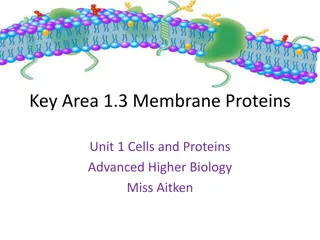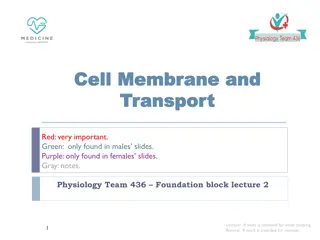
Unique Characteristics of Archeal Cell Membranes
Discover the distinct features of archeal cell membranes, including the chirality of glycerol, ether linkage, isoprenoid chains, and the replacement of lipid bilayers with monolayers. Explore how these differences contribute to the resilience of archaeans in harsh environments.
Download Presentation

Please find below an Image/Link to download the presentation.
The content on the website is provided AS IS for your information and personal use only. It may not be sold, licensed, or shared on other websites without obtaining consent from the author. If you encounter any issues during the download, it is possible that the publisher has removed the file from their server.
You are allowed to download the files provided on this website for personal or commercial use, subject to the condition that they are used lawfully. All files are the property of their respective owners.
The content on the website is provided AS IS for your information and personal use only. It may not be sold, licensed, or shared on other websites without obtaining consent from the author.
E N D
Presentation Transcript
Archeal cell membrane
Characteristics Chirality of glycerol : While bacteria and eukaryotes have D-glycerol in their membranes, archaeans have L-glycerol in theirs. Ether linkage : When side chains are added to the glycerol, most organisms bind them together using an ester linkage (see diagram above). The side chain that is added has two oxygen atoms attched to one end. One of these oxygen atoms is used to form the link with the glycerol, and the other protrudes to the side when the bonding is done. By contrast, archaeal side chains are bound using an ether linkage, which lacks that additional protruding oxygen atom. This gives the resulting phospholipid different chemical proerties from the membrane lipids of other organisms.
Ether linkage Isoprene unit
Isoprenoid chains : The side chains in the phospholipids of bacteria and eukaryotes are fatty acids, chains of usually 16 to 18 carbon atoms. Archaea do not use fatty acids to build their membrane phospholipids. Instead, they have side chains of 20 carbon atoms built from isoprene. Branching of side chains : Not only are the side chains of archaeal membranes built from different components, but the chains themselves have a different physical structure. Because isoprene is used to build the side chains, there are side branches off the main chain
In some archaea, the lipid bilayer is replaced by a monolayer. In effect, the archaea fuse the tails of two phospholipid molecules into a single molecule with two polar heads, this fusion may make their membranes more rigid and better able to resist harsh environments.






















